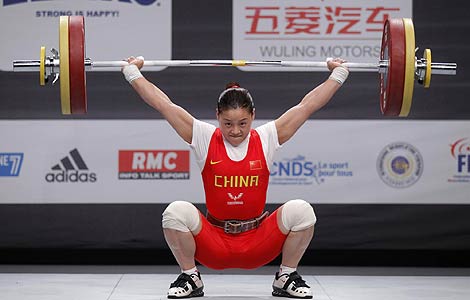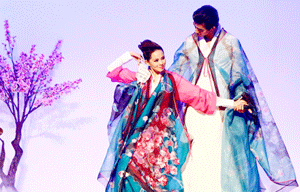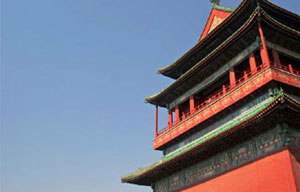Knots of fortune
Updated: 2011-11-04 08:47
By Chen Yingqun (China Daily European Edition)
|
|||||||||
|
The knot is another Chinese icon associated with prosperity and comes in all shapes and sizes. Zhang Zhenxiang / For China Daily |
Chinese embroidery is a traditional symbol of good luck and reunion
When China's first space lab module Tiangong-1 shot into space on Sept 29 it was carrying a very special cargo that thrilled millions of Chinese folk art fans. "It presented the folk art of the Chinese knot to the world and this was a great encouragement for us enthusiasts," says Li Ding, a 69-year-old folk artist in Beijing, who started learning Chinese knot-making skills when she was 6.
Li's pride and joy are shared by thousands of knot lovers in China, who have voluntarily set up online forums to exchange learning experience and creative designs with each other.
The long history of Chinese knots dates back to a time before characters when people kept records by tying knots.
The knot was then developed into a decorative handicraft art during the Tang (AD 618-907) and Song (960-1279) dynasties, and flourished in the Ming (1368-1644) and Qing (1644-1911) dynasties, says Li, who is also a noted designer.
Li is now applying to put Chinese knots on the World Intangible Cultural Heritage list, and expects this process to be completed soon.
The process requires approval from a local government, a city, a country and finally UNESCO.
Li has won over her local government in Beijing, and believes that the uniqueness of this craft will earn it international recognition.
"One major characteristic of Chinese knots is that all the knots are tied using one thread. However, when finished, the knot looks identical from both the front and back," Li says.
"The knots are so iconic and such a Chinese tradition. They deserve to be recognized as a cultural treasure."
Typically, knots are made in a square shape (see above) and are hung on doors or inside cars on the rearvision mirror.
Sometimes lucky symbols, such as fish, are attached and the knot can also be weaved into patterns of butterflies, flowers, birds, dragons, and even shoes.
A typical Chinese knot is red, which symbolizes good luck and prosperity but now new colors, such as gold, green, blue or black are being introduced.
As well as being used as a hanging decoration in the home and as an adornment to articles of clothing, examples of Chinese decorative knotting including rings, earrings, bracelets and necklaces, as well as small pendants that hang on bracelets and necklaces.
This seemingly simple art produces handicraft items that are intricately and exquisitely worked so therefore it is not surprising that the Chinese decorative knot is seen as a good luck charm.
No matter how different the knots appear, the message is always similar: a blessings of happiness, prosperity, love and good luck.
The delicate patterns and rich culture associated with knots have attracted many new fans.
Jiang Jing, from eastern Jiangsu province, has been learning knot making for more than two years but still calls herself a beginner.
"This form of art requires extensive knowledge and it's hard to get the soul of it," she says.
Another new fan, Yan Jie, says knot making is a terrific hobby. "The process of making the knots is challenging, but when you finish it, you have great satisfaction."
Zeng Yidi from Hangzhou started knotting about 10 years ago.
"In my mind, the knots have their own lives. It reflects the wisdom and great workmanship of the Chinese people. I am never bored watching these excellent knots take shape," he says.
"When I look at them, they really talk to me. It is amazing that countless shapes can be developed on the basis of the basic knot."
About 170,000 Chinese knots enthusiasts like Zeng have joinedzhongguojie.org, one of the largest online websites dedicated to the craft.
It was set up three years ago and already has triggered the formation of groups in more than 20 provinces and cities.
Most of the members are retired people, young white-collar workers and handiwork teachers.
Fans from the United States and Europe have also joined the club.
Zeng Yidi, who is in charge of both the eastern Hangzhou area and the overseas sub-groups, says that knotting enthusiasts in Hangzhou meet once a month at the public library, but there is not enough space.
"The place can only hold 40 people, and our group has at least 80 members ... we need a bigger place," he says.
Chinese knots declined in popularity during the middle of the last century, but made a strong comeback in the late 1990s, says Xiong Dadi, a noted designer in Taiwan.
Liu Yuying, who started a business making and selling Chinese knots in 2001, said that domestic demand has been on the rise.
The delicate art has become a favored ornament for most Chinese families during the lunar new year celebration.
Now almost every shopping mall in Beijing has a special counter selling Chinese knots of various sizes, shapes and colors.
According to Liu, Chinese knots have also become a way for companies to conduct promotion.
Many companies ask her to make knots with their logos or names on it, and then send them as gifts to their clients.
Xie Haibin, a Guangzhou-based businessman who specializes in Chinese knots sells most of his goods in the United States and Europe.
"Foreign customers are attracted because they think things made by manual workers feel better than things made by a machine," she says.
But the requirements of the knot have changed greatly over the years.
"Previously, Chinese knots with the simplest design and traditional red color could sell well, but now, customers are more particular about the color and designs of the knots."
However, Xie says overseas demand has dropped over the past three years.
Previously, about 90 percent of his goods were exported, but now only 50 percent will be sold abroad. He says the quality of exported knots has also fallen.
But Li Ding hopes UNESCO rankings will help boost the popularity of the knots around the world.












